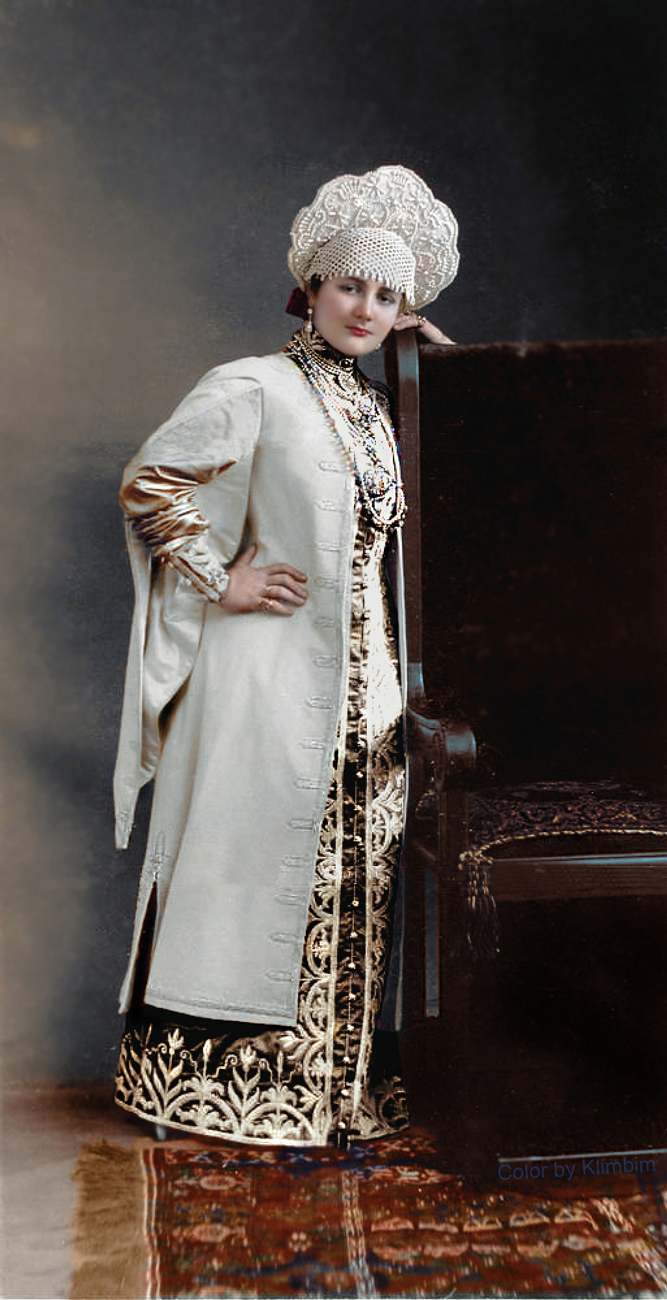Admire The Splendor Of Romanov House’s Final Ball Through These Stunning Colorized Costume Photos
The Romanov dynasty, a beacon of opulence and power in Russian history, hosted its final grand ball in February 1903 at the Winter Palace in St. Petersburg.
The Winter Palace, adorned with intricate chandeliers, gilded columns, and lavish decorations, set a grand stage for the ball. Vivid colors highlighted the palace’s luxury.
Guests enjoyed orchestral music and a live ballet of Swan Lake in Nicholas Hall before dancing into the night in elaborate costumes in the Pavilion Hall.
For a moment, let’s step back in time and enjoy these stunning photos colorized by Olga Shirnina, who works under the name Color By Klimbim. She used Photoshop to breathe new life into black-and-white photos from Russian history.
1. Nicholas II of Russia and Empress Alexandra Fyodorovna (granddaughter to Queen Victoria) dressed up for the 1903 Ball
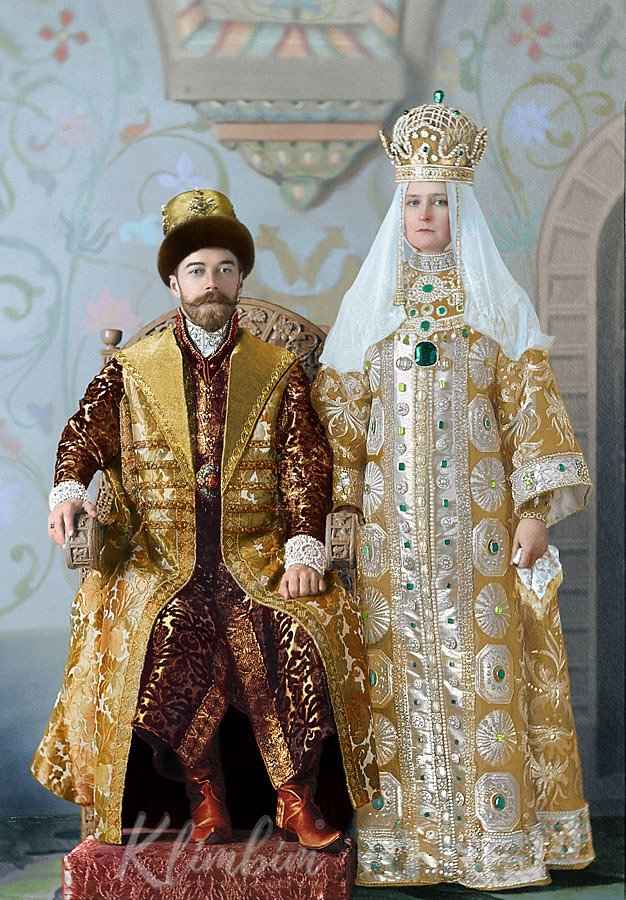
The 1903 grand affair was held on February 11 and 13 featuring visitors in bejeweled 17th-century-style costumes designed by artist Sergey Solomko with historical experts.
The costume ball was the grand plan of Empress Alexandra Fedorovna. She instructed all 390 guests to dress in 17th-century costumes. Court women wore sundresses and kokoshniks encrusted with precious stones, while men donned lavish overcoats and furs in the boyar style.
The entire Imperial family posed in rich 17th-century costumes for a final photograph in the Hermitage Theatre. Tsar Nicholas dressed as Alexis, and Tsaritsa Alexandra as Maria Miloslavskaya. Many wore priceless original items brought from the Kremlin.
Tsar Nicholas II and Empress Alexandra Feodorovna were the stars of the evening in their elaborately designed 17th-century Muscovite costumes. The colorized photos capture the richness of their attire, with intricate embroidery, lavish fabrics, and stunning jewels reflecting the light, adding to their regal aura.
2. Official Portrait of Nicholas II taken in the Concert Hall of the Winter Palace
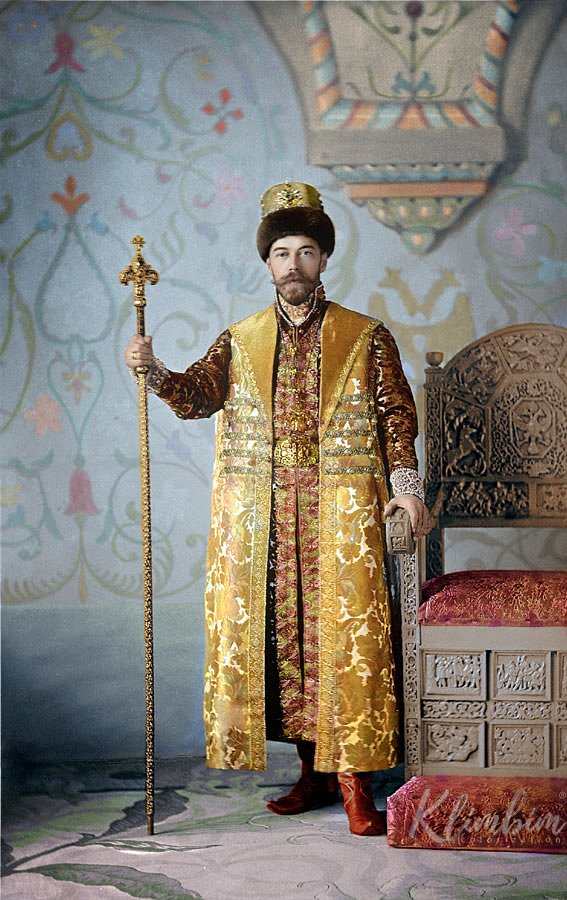
Tsar Nicholas II, seen here wearing the golden brocade of 17th-century Russian Tsar Alexey Mikhailovich, is one of the most well-known figures in Russian history.
He ruled Russia from November 1, 1894, until his forced abdication on March 15, 1917. He, along with his wife Alexandra, their five children, and three servants, were executed by firing squad on July 17, 1918.
The 1903 Winter Palace ball showcased this grandeur. For the background, photographers used a stand that imitated the walls of a 17th-century chamber of the Terem Palace in the Moscow Kremlin, installed in the Concert Hall of the Winter Palace.
The throne chair seen in the photo was a prop from the storeroom of the Hermitage Theatre.
3. Empress Alexandra Fedorovna’s magnificent costume
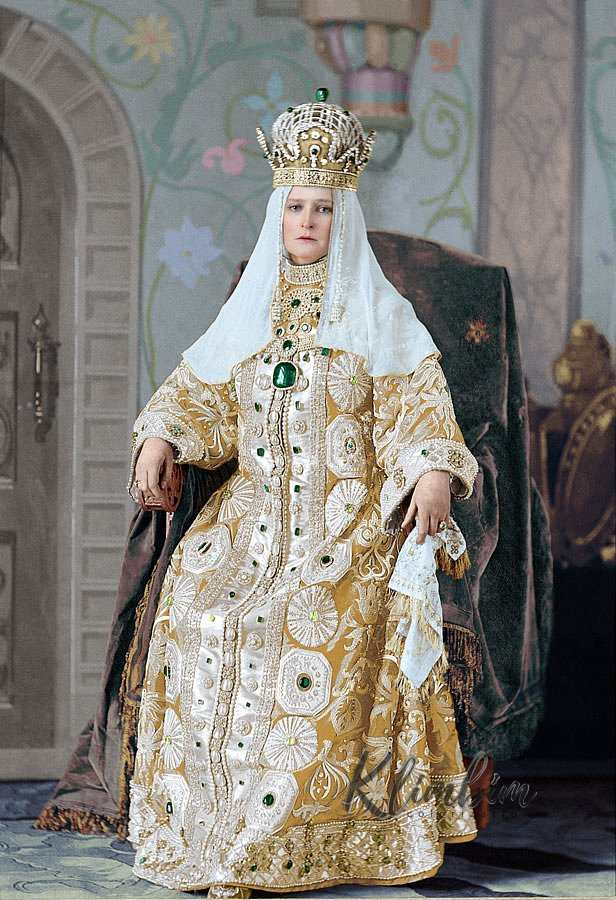
Empress Alexandra Fedorovna, pictured here, appeared at the ball dressed as Empress Maria Ilinichna, the first wife of Tsar Alexey Mikhailovich.
She wore a brocade dress adorned with silver satin and pearls, embellished by a diamond and emerald-studded crown and a magnificent emerald necklace selected by the court jeweler, Carl Fabergé. Today, such a dress would cost approximately 10 million euros.
Born into the German royal family of Hesse, Alexandra was the granddaughter of Queen Victoria.
Empress Maria Ilinichna was the mother of Tsar Feodor III. Following a Byzantine custom likely introduced by Sophia Palaiologina, she had been chosen as a bride for her beauty among two hundred aristocratic candidates specially summoned to the court.
4. Grand Duchess Xenia Alexandrovna of Russia’s stunning costume
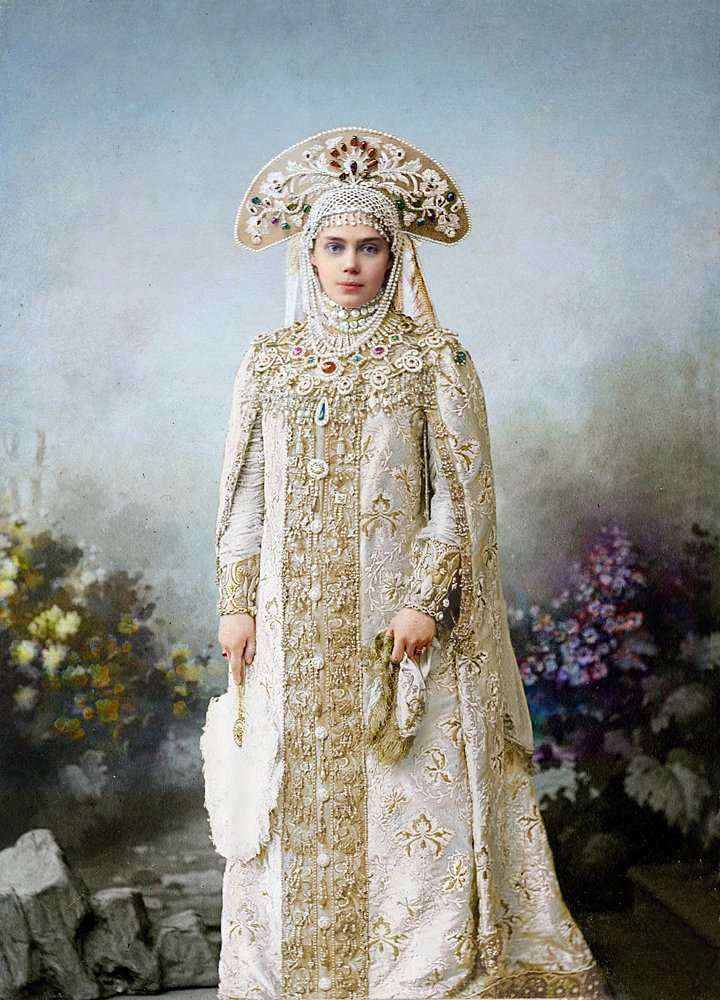
Grand Duchess Xenia Alexandrovna, the younger sister of Nicholas II, dressed as a boyar for the 1903 Winter Palace ball. Her costume later inspired Trisha Biggar, the costume designer for The Phantom Menace, to create one of Princess Amidala’s dresses.
Grand Duke Alexander Mikhailovich, her husband, wrote about the dress: “Ksenia was dressed as a boyar’s wife, her costume was richly decorated and sparkling with jewels that suited her well.”
The elaborate attire, with its intricate details and shimmering jewels, highlighted the grandeur and opulence of the era.
5. Princess Olga Orlova in Masquerade Costume for the Ball
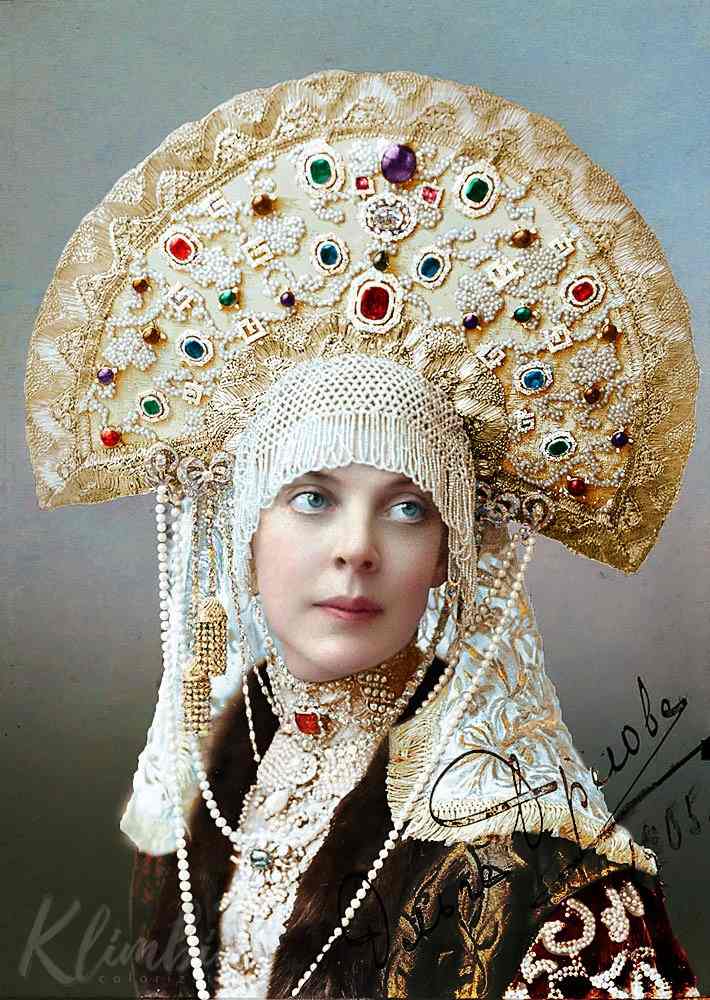
Princess Olga Orlova was another standout at the 1903 Winter Palace ball, mesmerizing everyone with her elegant masquerade costume.
Her attire, like the other guests, was inspired by the opulent style of the 17th century, adding to the splendor of the evening. Her costume featured intricate designs and luxurious fabrics, embodying the extravagance of the era.
With her regal presence and exquisite outfit, Princess Olga Orlova epitomized the glamour and sophistication of the Romanov court during this grand celebration.
6. Princess Zinaida Yusupov in a stunning masquerade costume
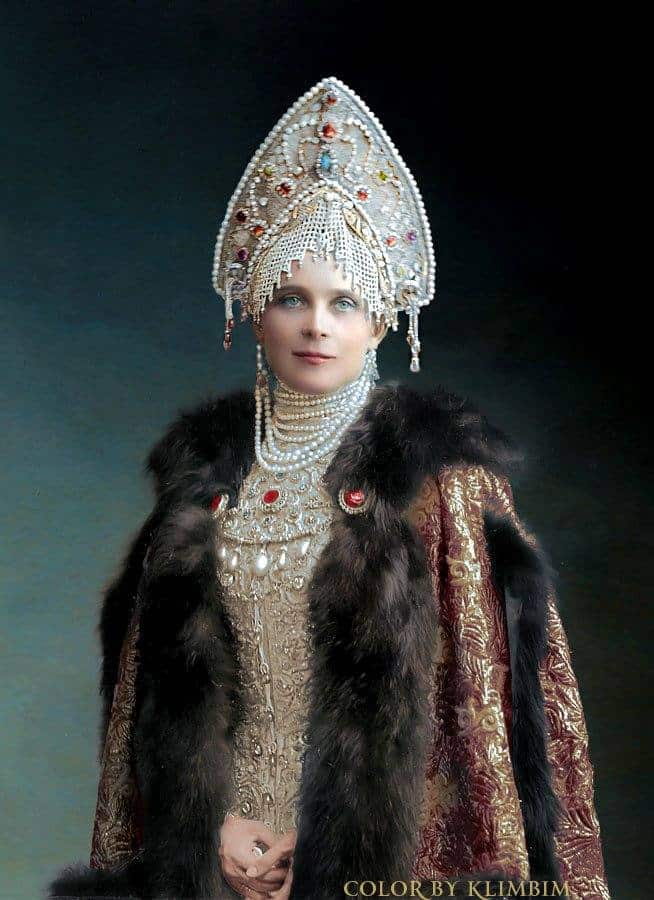
Princess Zinaida Yusupova, a prominent figure of pre-revolutionary Russia, attended the 1903 Winter Palace ball in a stunning masquerade costume.
She was part of the illustrious Yusupov family, the mother of Prince Felix Yusupov, and the mother-in-law of Princess Irina Alexandrovna, who was the niece of Emperor Nicholas II.
Princess Zinaida was the greatest Russian heiress of her time and the last of her line in the House of Yusupov. Renowned for her blue-eyed beauty and her lavish hospitality, she left a lasting impression on Russian society.
The colorized photo by Olga Shirnina captures the elegance and opulence of Princess Zinaida’s attire, highlighting the intricate details and luxurious fabrics that made her one of the most admired figures at the ball.
7. Madamoiselle Anastasiya Korsakova at Winter Ball
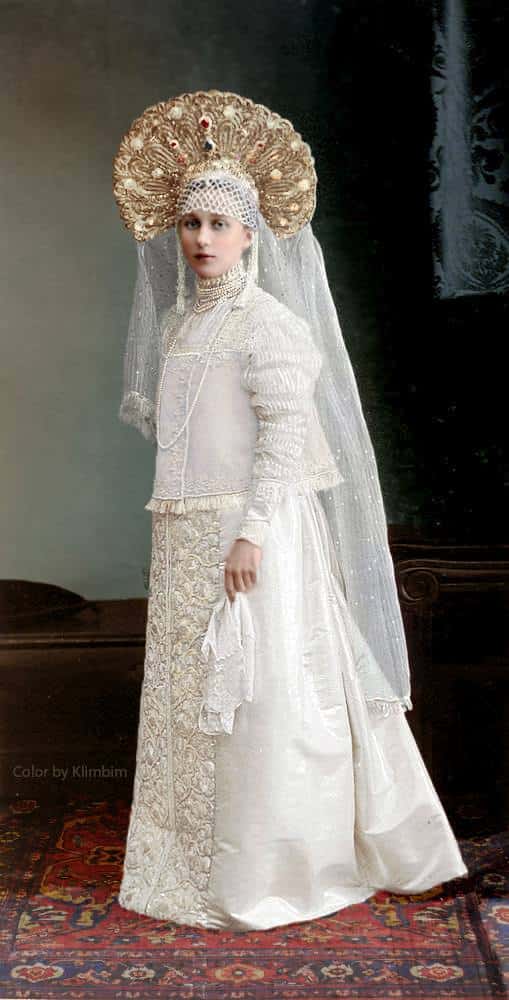
The image shows Madamoiselle Anastasiya Korsakova at the 1903 Winter Ball, beautifully colorized by Olga Shirnina.
Anastasiya dressed in an exquisite, traditional gown. Her headdress, a lavish kokoshnik, features ornate gold elements and delicate pearls, complementing the luxurious fabric of her gown. The meticulous embroidery and the flowing veil add to the overall grandeur of her attire.
The colorization freshens the image, enhancing the textures and subtle hues of the dress and accessories. The deep reds and blues on the carpet, the soft tones of her attire, and the gentle blush on her face are vividly portrayed, offering a more immersive glimpse into this historical moment.
8. Mademoiselle Alexandra Taneeva in a ball gown
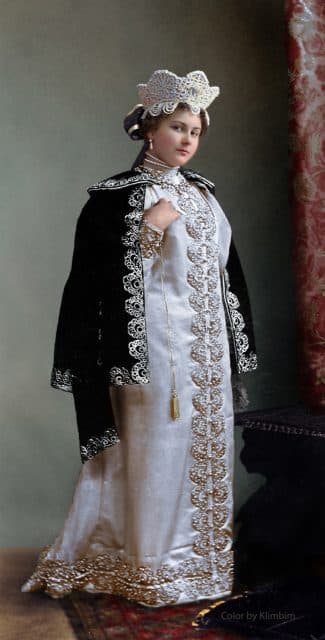
In this photograph, Alexandra Taneeva is elegantly in a stunning white dress with elaborate gold embroidery, paired with a rich black cloak adorned with similar detailed patterns.
The soft white of her gown, the deep black of her cloak, and the gold details are vividly brought to the forefront, providing a more immersive and realistic view of the scene. Her intricately designed headdress complements the elegant overall look.
9. Cornette Kolioubakine at the 1903 Winter Ball
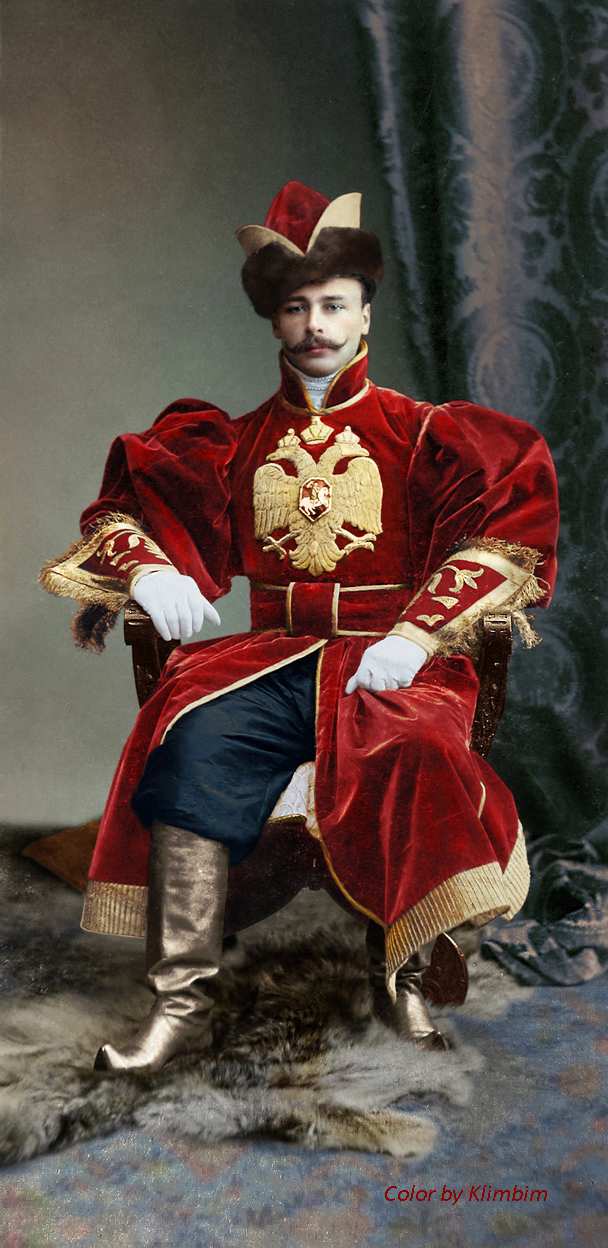
The image, colorized by Olga Shirnina, shows Cornette Kolioubakine at the 1903 Winter Ball. He is seated in an opulent red robe with gold embroidery featuring the imperial Russian double-headed eagle emblem.
The detailed colorization highlights the rich fabric and craftsmanship, making the outfit’s textures and colors vivid and lifelike. His fur hat, white gloves, and polished boots provide a vibrant glimpse into early 20th-century high society.
10. Baroness Emma Freedericksz April 1903

Baroness Emma Freedericksz in 17th-century boyarishnya’s attire at the 1903 dance ball. She wore an elaborate gown with embroidery and pearls.
Her look was outstanding with a stunning kokoshnik with jewels and detailed designs. Her luxurious fur-trimmed cloak was adorned with gold leaf patterns, making her regal look.
11. The Countess Fersen, born Princess Dolgoruky, in her costume
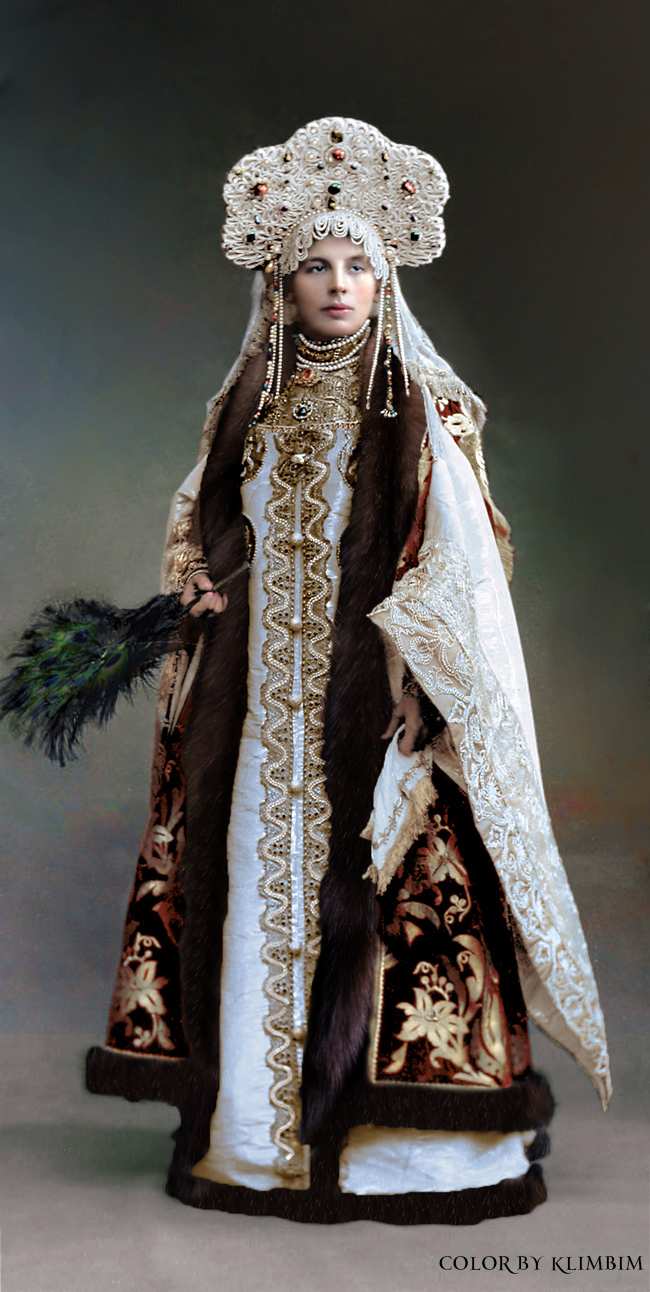
The Countess Fersen, born Princess Dolgoruky, joined the 1903 ball in a magnificent traditional Russian costume.
She was dressed in a richly adorned gown with intricate embroidery and a luxurious fur-trimmed cloak. Her kokoshnik headdress, detailed with pearls and gemstones, adds to her regal appearance. Her elegance was enhanced with a peacock feather fan.
12. Portrait of Princess Elisabeth Obolensk

Princess Elisabeth Obolensky, a lady-in-waiting to Empress Alexandra Feodorovna, attended the Winter Ball of 1903 dressed as a young boyar woman from the 17th century.
Princess was born into the Obolensky family, one of Russia’s most ancient and noble houses, which traced its lineage back to the Rurik dynasty, which ruled over parts of Russia and Ukraine.
Elisabeth’s role as a lady-in-waiting allows her to witness and participate in the daily life and significant events of the Romanov family.
Boyars were the highest-ranking members of the Russian aristocracy before the rise of the Romanovs, and their attire was richly decorated with luxurious fabrics, embroidery, and lavish jewelry. Elisabeth’s costume reflected this opulence and symbolized her noble lineage.
13. Maid of honor, Princess E.V. Baryatinskaya
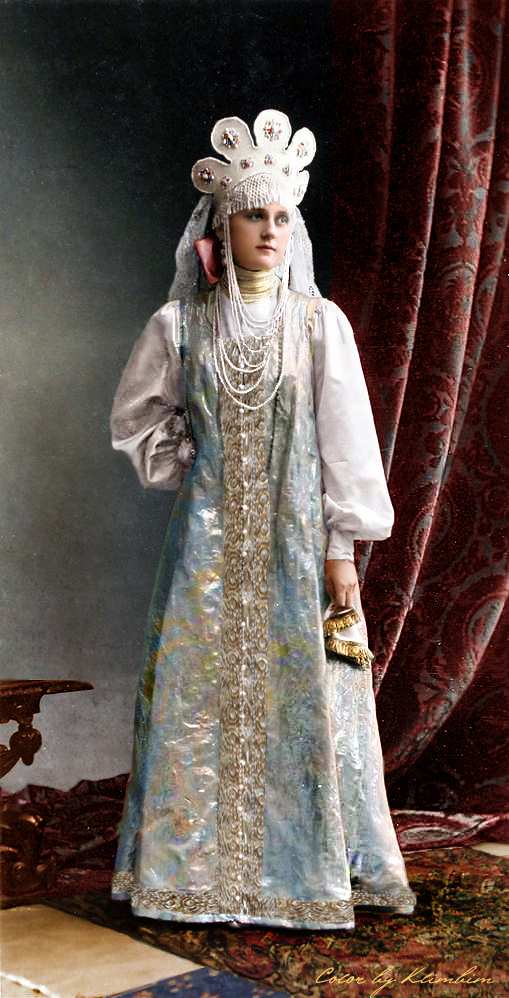
Princess Elizaveta Vladimirovna Baryatinskaya, a maid of honor to Empress Alexandra Feodorovna, attended the 1903 Winter Ball dressed for the performance of a traditional Russian dance.
The costume she wore features opulent fabric, unique embroidery, and ornate embellishments. Her kokoshnik is adorned with jewels and pearls, adding to the regal appearance.
The Baryatinskaya family was one of the oldest and most distinguished noble families in Russia. As a maid of honor, she would have had close interactions with the Empress and other members of the royal family, participating in various court activities and ceremonies.
14. Madame Tatischeva Portrait
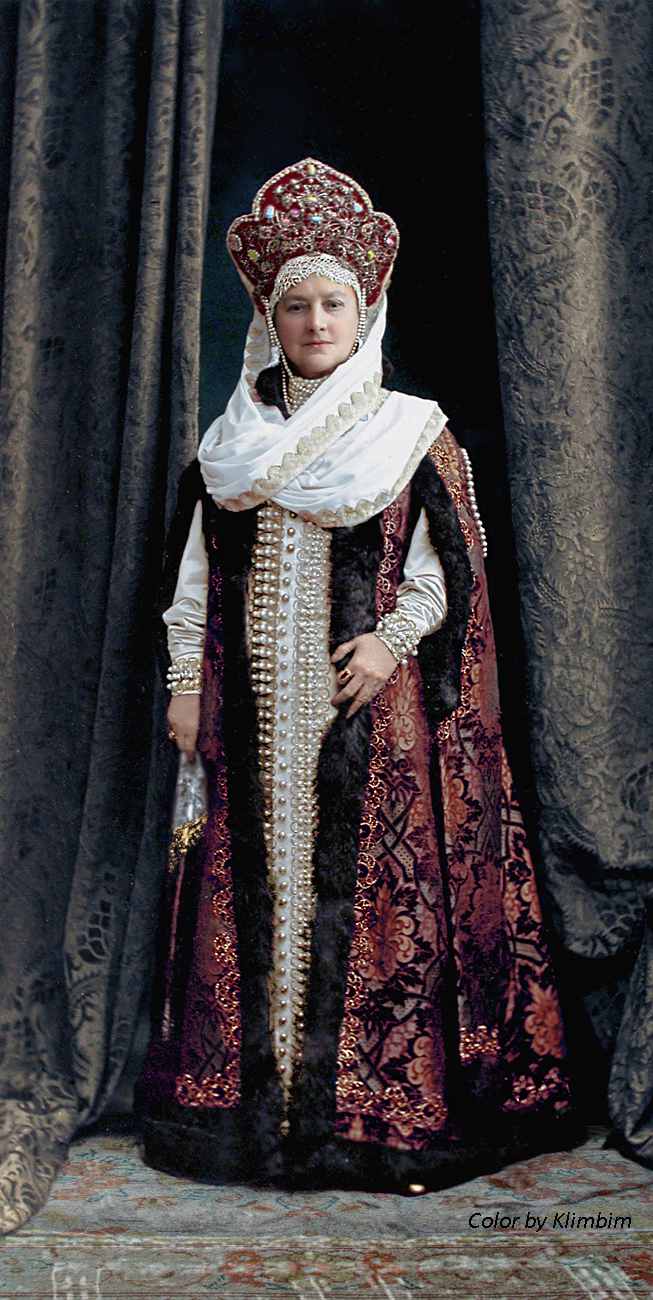
Madame Tatischeva was a prominent figure in Russian high society, associated with the Russian imperial court, particularly during the reign of Tsar Nicholas II.
Madame Tatischeva from the House of Tatischev or Tatishchev, a distinguished Russian noble family traditionally believed to be descended from the Princes of Solomerech of the Rostislavichi of Smolensk. She is a participant in the famous 1903 Winter Ball.
15. Countess Elisabeth Moussine Pushkina
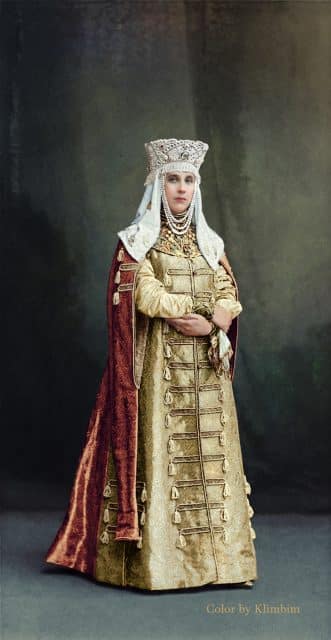
Countess Elisabeth Moussine Pushkina was the daughter of Hilarion Ivanovitch Comte Worontzov-Dachkov (May 27, 1837 – January 25, 1916) and Elisabeth Andréievna Comtesse Schouvalov (July 25, 1845 – July 15, 1924, Wiesbaden, Hessen, Germany).
Her marriage to Vladimir Vladimirovich Musin-Pushkin (February 8, 1870 – September 29, 1943) further solidified her position within the Russian aristocracy.
Countess Elisabeth’s participation in high-society events, such as the 1903 Winter Ball at the Winter Palace in St. Petersburg, underscored her status and elegance.
16. Countess Keller, born Princesse Schakhovskoy, pictured at the Ball
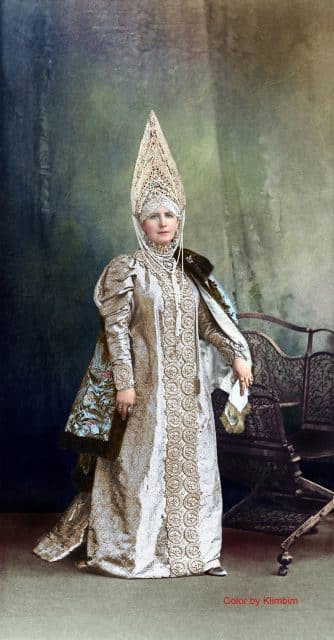
The Schakhovskoy family, to which she belonged, is a notable noble family in Russia with a history of significant contributions to the cultural and political landscape of the empire.
Her marriage to Count Keller further elevated her status, intertwining her with another prominent noble lineage.
17. Madame Voyeïkow, nee Baronne Freedericksz (Femme de boyard, epoque du Tsar Alexis Mikhailovitch)
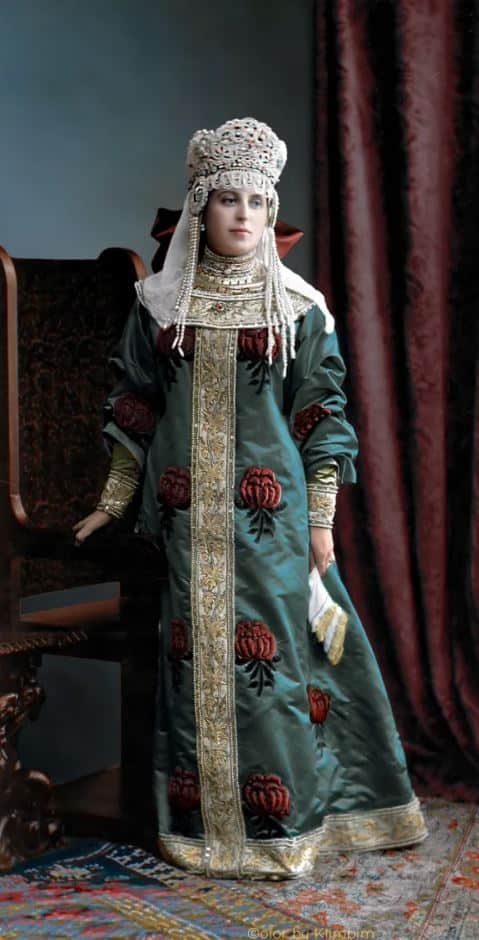
Madame Voyeïkow, née Baronne Freedericksz, was known for her noble lineage and esteemed position at the imperial court.
At this grand affair, Madame Voyeïkow donned a costume inspired by a “Femme de boyard” (Boyar woman) from the era of Tsar Alexis Mikhailovitch. Her attire would have featured elaborate detailing and opulent materials, characteristic of the traditional dress of the 17th-century Russian nobility.
18. Anna Vyrubova, a lady-in-waiting, with her sister
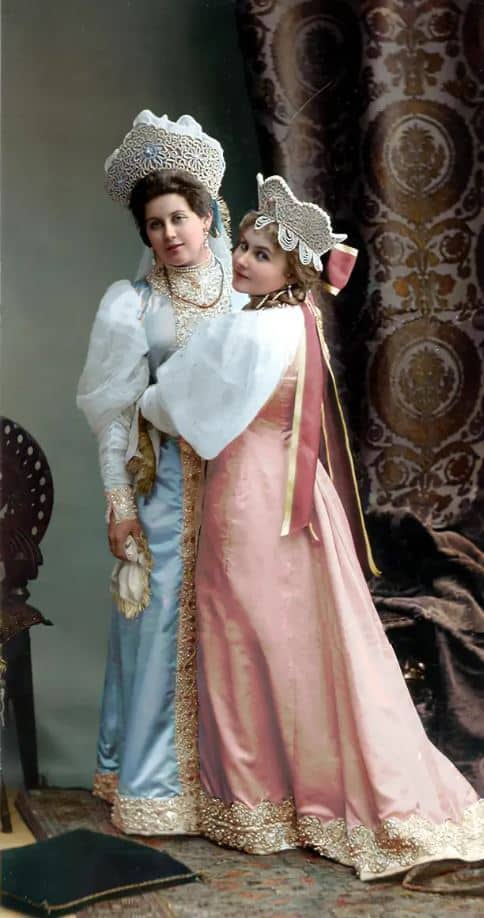
Anna Vyrubova attended the 1903 Winter Ball, accompanied by her sister, making the occasion a family affair.
At the ball, Anna and her sister would have worn costumes inspired by historical Russian attire symbolizing the wealth and sophistication of the Russian aristocracy.
19. Guards Captain N.N. Mansurov with his wife M.A. Mansurova in the outfits of the times of Tsar Alexei Mikhailovich
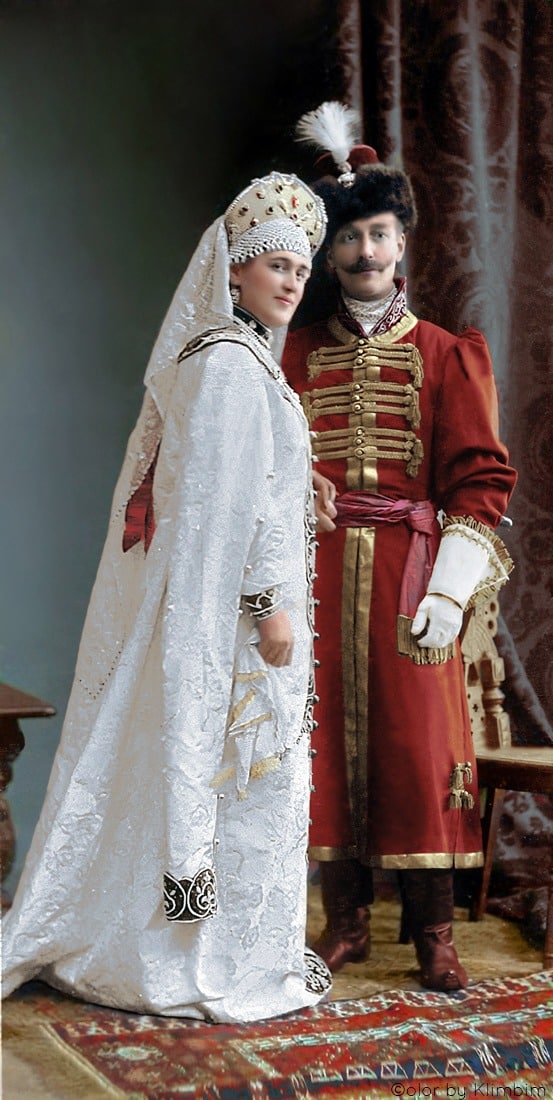
Guards Captain N.N. Mansurov and his wife M.A. Mansurova dressed in splendid outfits inspired by the times of Tsar Alexei Mikhailovich.
His attire was meticulously designed to represent the distinguished military and noble dress of the 17th century. His costume likely featured richly adorned fabrics, intricate embroidery, and traditional elements such as a kaftan and a sable fur hat.
M.A. Mansurova’s costume would have complemented her husband’s, showcasing the elegance and sophistication of a noblewoman’s dress from the same period.
20. Portrait of Princess Barbe Dolgorouky
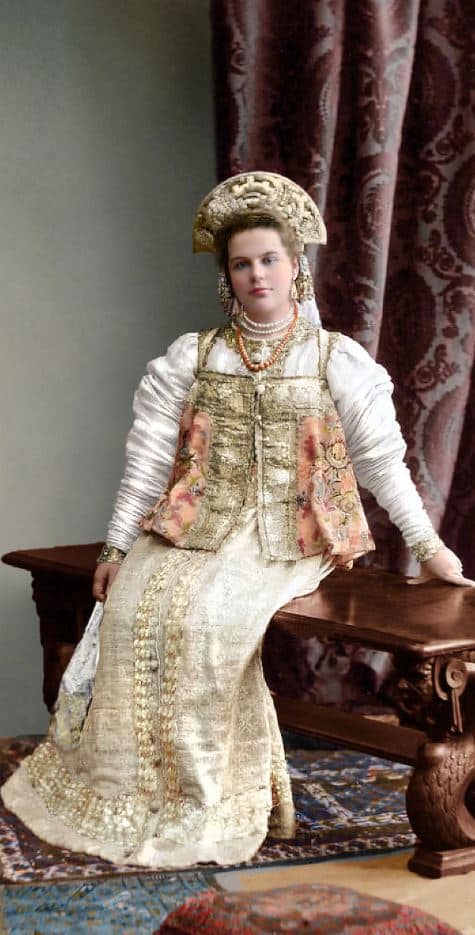
Princess Barbe Dolgorouky, also known as Varvara Dolgorukova, was a member of the illustrious Dolgorukov family. The Dolgorukovs trace their lineage back to the Rurik dynasty and played a significant role in the history and governance of Russia.
The Dolgorukov family held prominent positions in the Russian Empire, contributing to its political, military, and cultural spheres. Members of the family were often involved in key events and held influential roles within the court and government.
The princess’s presence in Russian high society reflected the family’s longstanding tradition of nobility and service to the empire. Her participation in the 1903 Winter Ball underscored the family’s prominence and the deep-rooted heritage that they represented within the aristocracy.
21. Countess Elisabeth Cheremetew
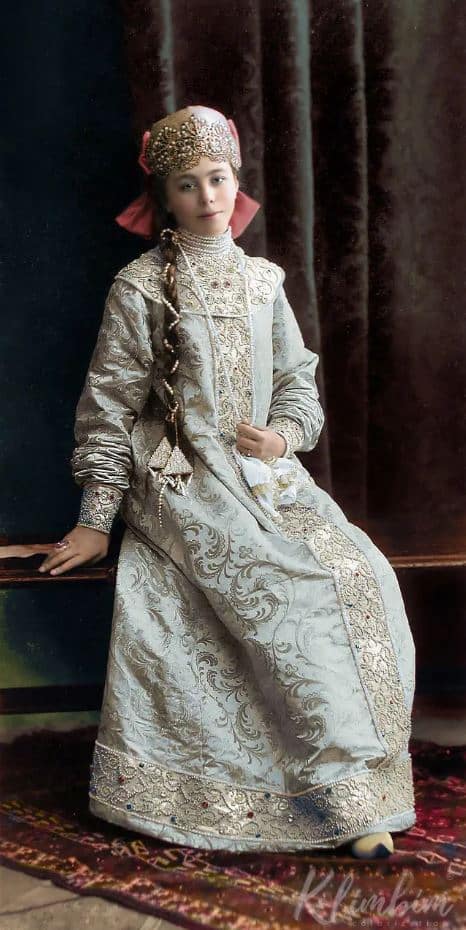
Countess Elisabeth Cheremetew hailed from the influential Sheremetev family. The Sheremetev family was known for their immense wealth and significant contributions to Russian culture and politics.
The Sheremetevs owned vast estates and were patrons of the arts, significantly influencing Russian cultural development. Their palatial homes and involvement in cultural activities, such as theatre and music, underscored their position and wealth.
22. La Comtesse Karlow, nee Vonlarsky (Femme de boyard du XVII siecle)

La Comtesse Karlow, née Vonlarsky, wore a 17th-century Boyarynya (noblewoman) costume at the 1903 Winter Ball.
The Vonlarsky lineage belonged to the Russian nobility, and her union with the Karlow family solidified her standing in elite circles.
23. Mademoiselle Marie Voyeïkow, Demoiselle d’honneur de Leurs Majestés les Impératrices (Jeune fille boyard du XVII siècle) 1903
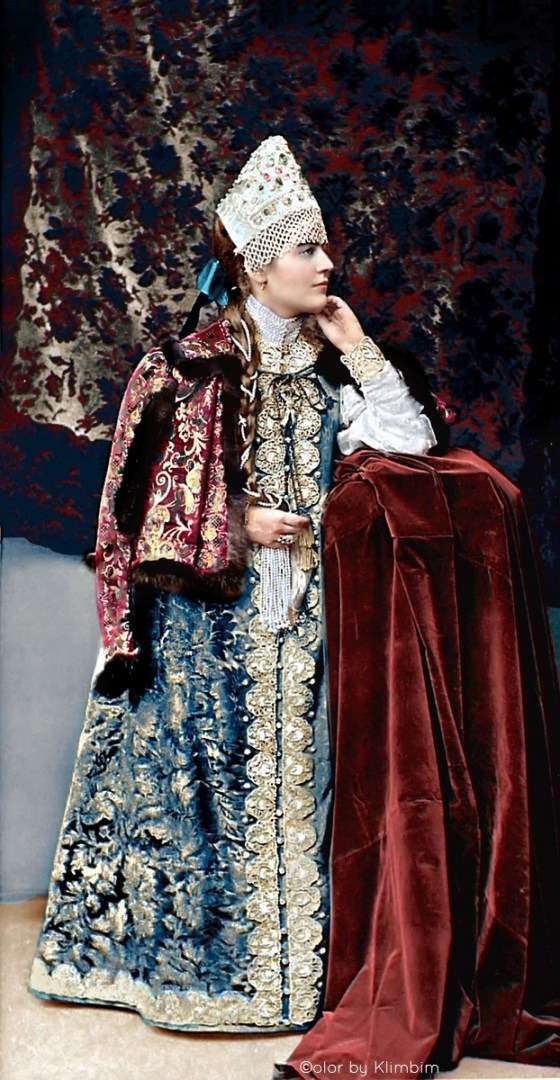
Mademoiselle Marie Voyeïkow’s position as a maid of honor to Their Majesties, the Empresses, put her in intimate contact with the Russian imperial family.
Her appearance and outfit at the ball highlighted the event’s deep sense of tradition and cultural pride of the Russian aristocracy.
24. La Princesse Koudaschew, nee Comtesse Nieroth
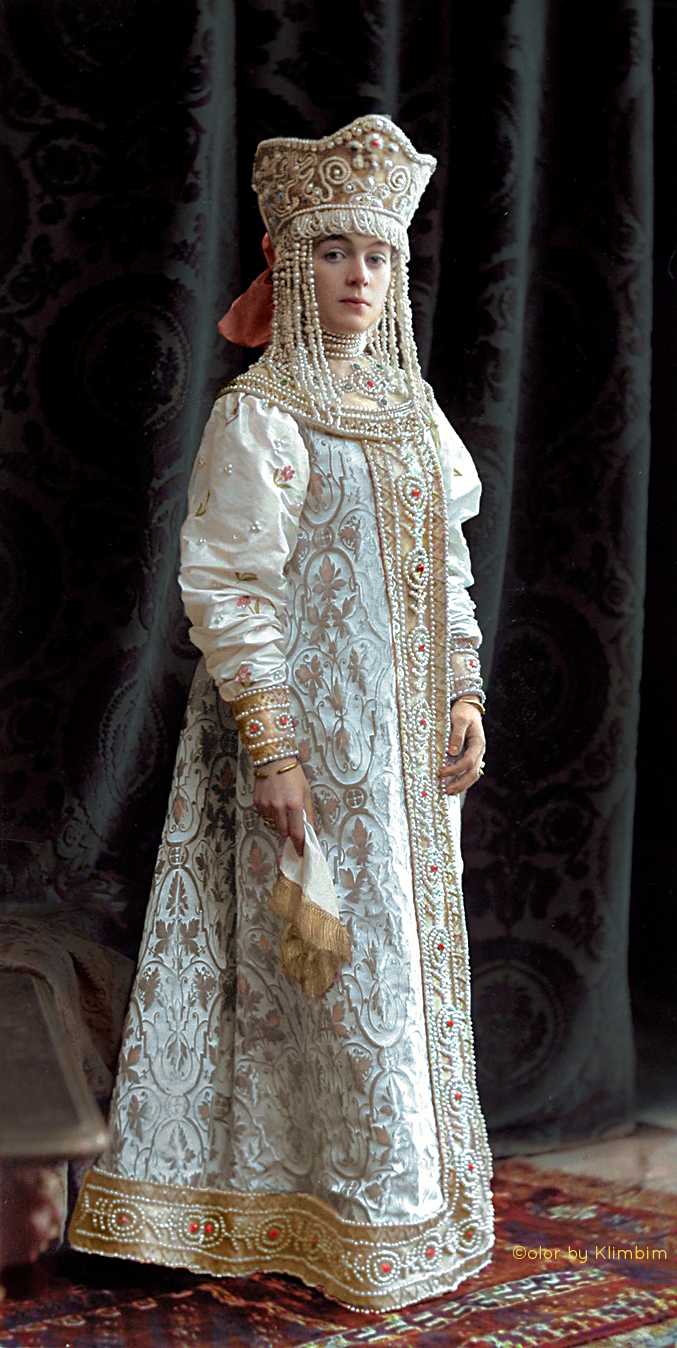
Princess Vera Maximilianovna Kudasheva, née Nirod, graced the 1903 Winter Ball held at the Winter Palace by Nicholas II in a traditional Russian costume.
Her costume was a stunning representation of the opulent attire worn by Russian nobility during the era of the boyars.
25. Grand Duke Alexander Mikhailovich
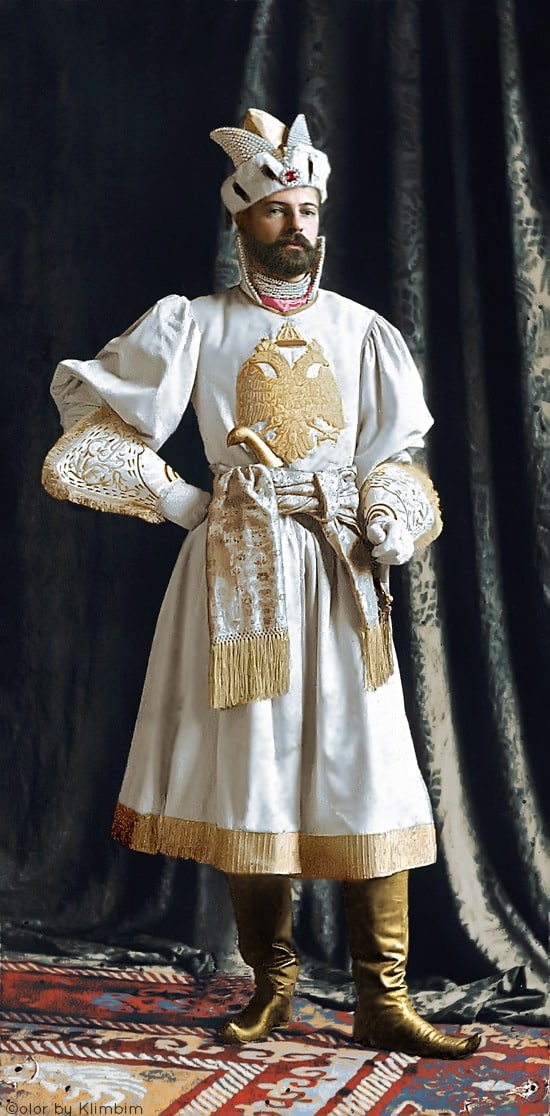
Grand Duke Alexander Mikhailovich of Russia, born April 13, 1866, was a key figure in the Romanov dynasty and a significant contributor to the modernization of the Russian Navy.
Known as “Sandro,” he married Grand Duchess Xenia Alexandrovna, sister of Tsar Nicholas II, linking him closely to the reigning family. They had seven children.
Alexander Mikhailovich supported various social and economic reforms, including aviation development.
His life dramatically changed with the 1917 Russian Revolution, which led to the Romanov dynasty’s fall. Exiled, he spent his later years in France, where he remained active in cultural and social activities until his death on February 26, 1933.
26. Mademoiselle Dorothee Bibikow 1903
